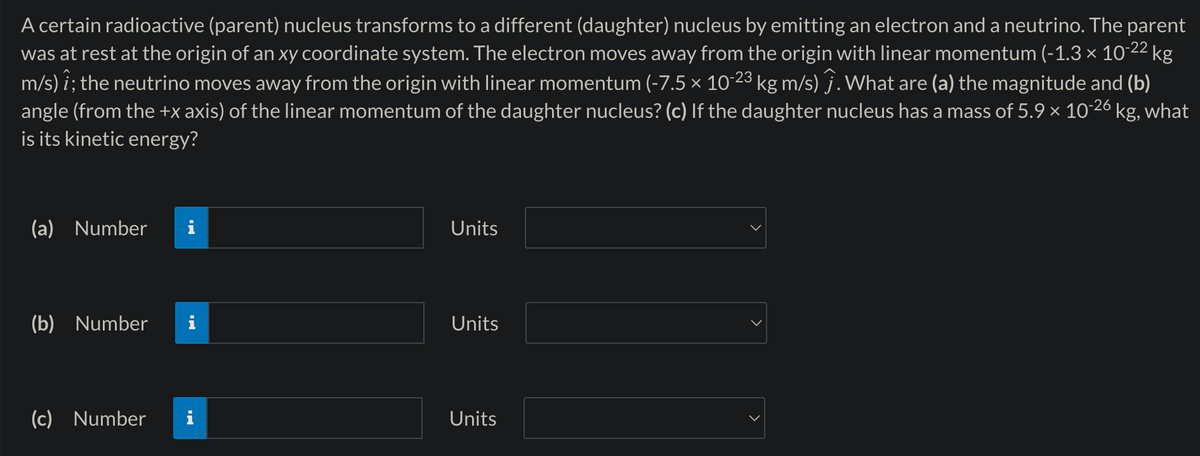A certain radioactive (parent) nucleus transforms to a different (daughter) nucleus by emitting an electron and a neutrino. The parent was at rest at the origin of an xy coordinate system. The electron moves away from the origin with linear momentum (-1.3 × 10-22 kg m/s) i; the neutrino moves away from the origin with linear momentum (-7.5 × 10-23 kg m/s) Ĵ. What are (a) the magnitude and (b) angle (from the +x axis) of the linear momentum of the daughter nucleus? (c) If the daughter nucleus has a mass of 5.9 × 10-26 kg, what is its kinetic energy? (a) Number i Units (b) Number i Units (c) Number i Units
A certain radioactive (parent) nucleus transforms to a different (daughter) nucleus by emitting an electron and a neutrino. The parent was at rest at the origin of an xy coordinate system. The electron moves away from the origin with linear momentum (-1.3 × 10-22 kg m/s) i; the neutrino moves away from the origin with linear momentum (-7.5 × 10-23 kg m/s) Ĵ. What are (a) the magnitude and (b) angle (from the +x axis) of the linear momentum of the daughter nucleus? (c) If the daughter nucleus has a mass of 5.9 × 10-26 kg, what is its kinetic energy? (a) Number i Units (b) Number i Units (c) Number i Units
Principles of Physics: A Calculus-Based Text
5th Edition
ISBN:9781133104261
Author:Raymond A. Serway, John W. Jewett
Publisher:Raymond A. Serway, John W. Jewett
Chapter8: Momentum And Collisions
Section: Chapter Questions
Problem 1OQ
Related questions
Topic Video
Question

Transcribed Image Text:A certain radioactive (parent) nucleus transforms to a different (daughter) nucleus by emitting an electron and a neutrino. The parent
was at rest at the origin of an xy coordinate system. The electron moves away from the origin with linear momentum (-1.3 × 10-22 kg
m/s) i; the neutrino moves away from the origin with linear momentum (-7.5 × 10-23 kg m/s) Ĵ. What are (a) the magnitude and (b)
angle (from the +x axis) of the linear momentum of the daughter nucleus? (c) If the daughter nucleus has a mass of 5.9 × 10-26 kg, what
is its kinetic energy?
(a) Number
Units
(b) Number
Units
(c) Number
Units
Expert Solution
This question has been solved!
Explore an expertly crafted, step-by-step solution for a thorough understanding of key concepts.
Step by step
Solved in 4 steps with 4 images

Knowledge Booster
Learn more about
Need a deep-dive on the concept behind this application? Look no further. Learn more about this topic, physics and related others by exploring similar questions and additional content below.Recommended textbooks for you

Principles of Physics: A Calculus-Based Text
Physics
ISBN:
9781133104261
Author:
Raymond A. Serway, John W. Jewett
Publisher:
Cengage Learning

Physics for Scientists and Engineers: Foundations…
Physics
ISBN:
9781133939146
Author:
Katz, Debora M.
Publisher:
Cengage Learning

College Physics
Physics
ISBN:
9781285737027
Author:
Raymond A. Serway, Chris Vuille
Publisher:
Cengage Learning

Principles of Physics: A Calculus-Based Text
Physics
ISBN:
9781133104261
Author:
Raymond A. Serway, John W. Jewett
Publisher:
Cengage Learning

Physics for Scientists and Engineers: Foundations…
Physics
ISBN:
9781133939146
Author:
Katz, Debora M.
Publisher:
Cengage Learning

College Physics
Physics
ISBN:
9781285737027
Author:
Raymond A. Serway, Chris Vuille
Publisher:
Cengage Learning

University Physics Volume 1
Physics
ISBN:
9781938168277
Author:
William Moebs, Samuel J. Ling, Jeff Sanny
Publisher:
OpenStax - Rice University

Physics for Scientists and Engineers with Modern …
Physics
ISBN:
9781337553292
Author:
Raymond A. Serway, John W. Jewett
Publisher:
Cengage Learning

College Physics
Physics
ISBN:
9781305952300
Author:
Raymond A. Serway, Chris Vuille
Publisher:
Cengage Learning